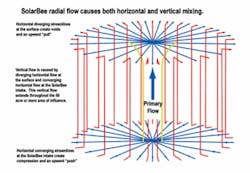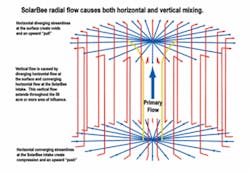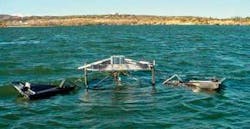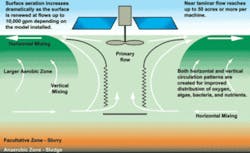System Offers Long-Distance, Low-Energy Water Circulation
Water quality in wastewater treatment ponds, freshwater lakes and potable water tanks can be improved by proper mixing, but the cost to achieve sufficient circulation through diffused aeration or mechanical mixers can be high or even prohibitive for water bodies with surface areas greater than five acres or volumes over several million gallons.
To address this problem, engineers and scientists at Pump Systems Inc. developed the SolarBee® solar-powered floating water circulation system. Engineered to provide low-lift water action, each unit can circulate up to 10,000 gallons per minute with a “near laminar” flow that allows for efficient long-distance mixing.
Both the volume and distance capabilities have been proven through dye testing. With the capability of mixing over 14 million gallons per day, a single unit can service a 40-acre lake or 200 million gallon reservoir.
Key to the SolarBee design is its ability to raise water from any desired depth with only 0.2 inches of lift force. This means that very little “work” must be performed. The water being circulated will travel long distances in a laminar flow across the surface of a reservoir while also causing highly efficient circulation underneath the surface.
“In many wastewater aeration ponds, managers use a lot of horsepower to pump and mix water with devices that sometimes look like boat propellers,” said Joel Bleth, an expert on water chemistry and fluid dynamics and co-founder of Pump Systems Inc. “This is a very inefficient and ineffective approach. Under relatively high pressure, the turbulent water gets ‘bunched up’ and does not flow efficiently. Plus, the underwater suction created by such pumps further limits the circulation by pulling some of the circulation back into the pump before much aeration occurs.”
Bleth says that most aeration pumps have an effective range of only about 50 feet in any direction, with a total range of influence of only about half an acre. Conversely, with its gentle yet high-volume flow, a single SolarBee can effectively mix acres of wastewater. At the same time, there is considerable energy savings available.
A five-acre, eight foot deep pond, for example, requires aerating approximately 13 million gallons.
“You need 30 HP to supply the needed oxygen,” Bleth said. “But for conventional mixing of 13 million gallons, a partial-mix system will require about 10 HP per million gallons, or 130 HP. So, that’s where a SolarBee can provide substantial savings. The pond manager can use only 30 HP to develop the necessary oxygen, and our system can do the mixing using on-board solar power.”
For intensely loaded industrial and municipal wastewater applications, depending on mix requirements, each solar-powered unit will cover from one to 15 acres.
In wastewater back-end cells (settling and finishing ponds), where oxygen requirements are lighter, the SolarBee system can also provide algae control. The water in these cells is still sufficiently high in nutrients to support the development of a new BOD (including toxin-producing blue-green algae), which could cause a permit violation if discharged.
“With its long-distance, high-volume circulation, the SolarBee system will protect back-end ponds by favoring the good, edible algae over the blue-greens,” Bleth said. “Then the daphnia and zooplankton can kick in that last cell and eat the good algae. At that point you won’t have algae in the water column that you are discharging, so you won’t violate your BOD-permit.”
In a freshwater lake, where nutrients are much lower than in a wastewater pond, high-volume, circulation still offers important benefits.
In freshwater applications, SolarBee units can be spaced up to 45 acres apart. The long-distance circulation created will allow the “good algae” to out-compete the toxin-producing blue-green algae (BGA), allowing the good algae to uptake the nutrients. Therefore, even in warm weather, the BGA never gets traction.
The SolarBee system can be equipped with SCADA output signals, a chlorine injection system, and with various solar and 24-hour power kits as needed depending on reservoir characteristics. The system’s flotation system, together with the variable length intake hose, self adjusts at all times for peak performance regardless of water depth in the reservoir.




